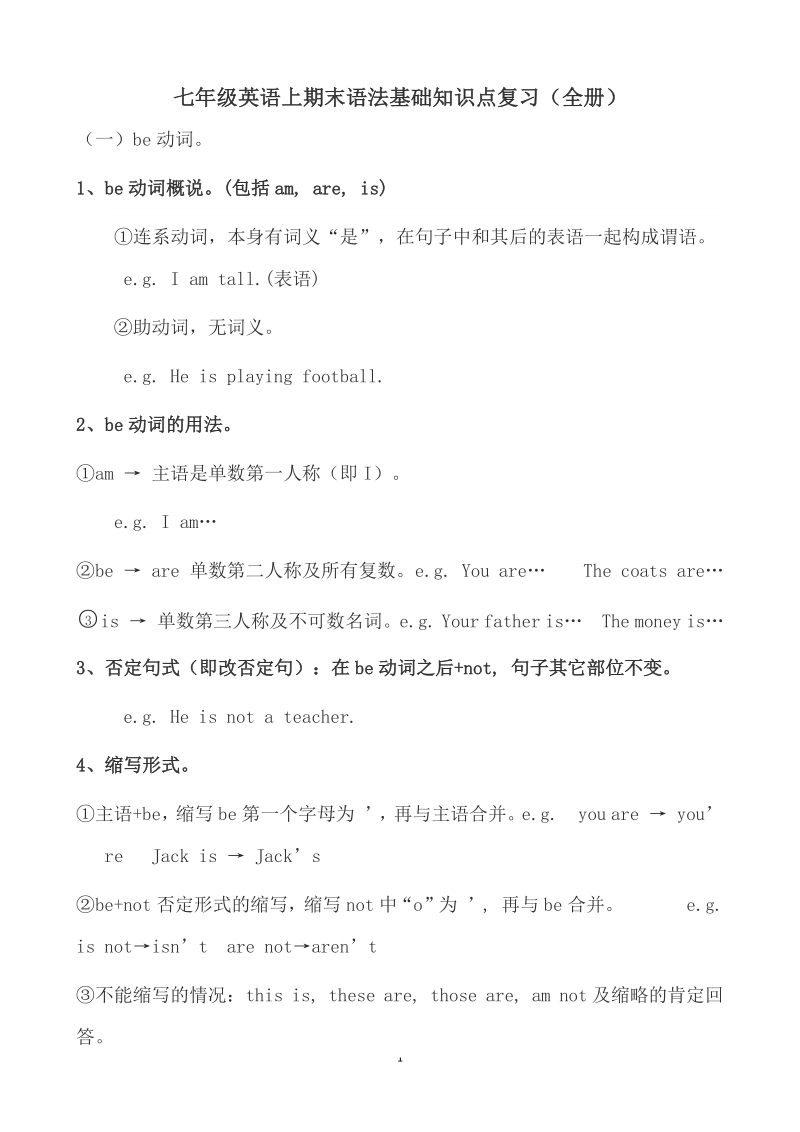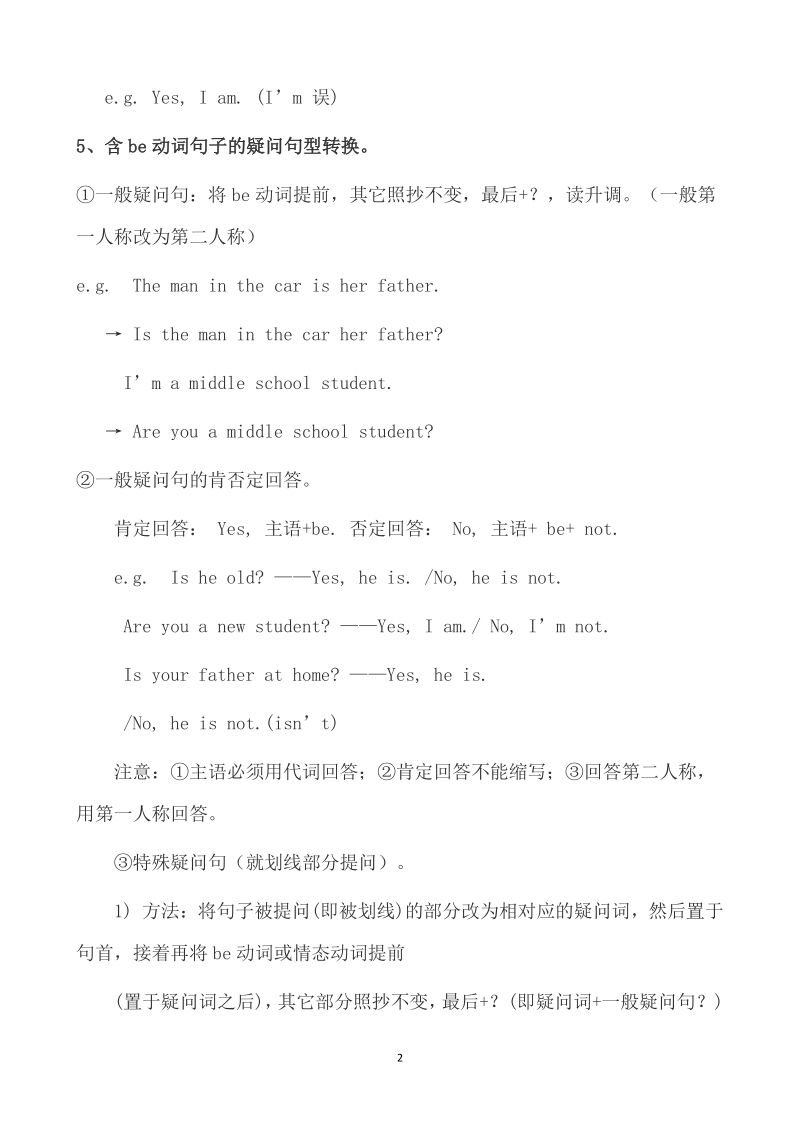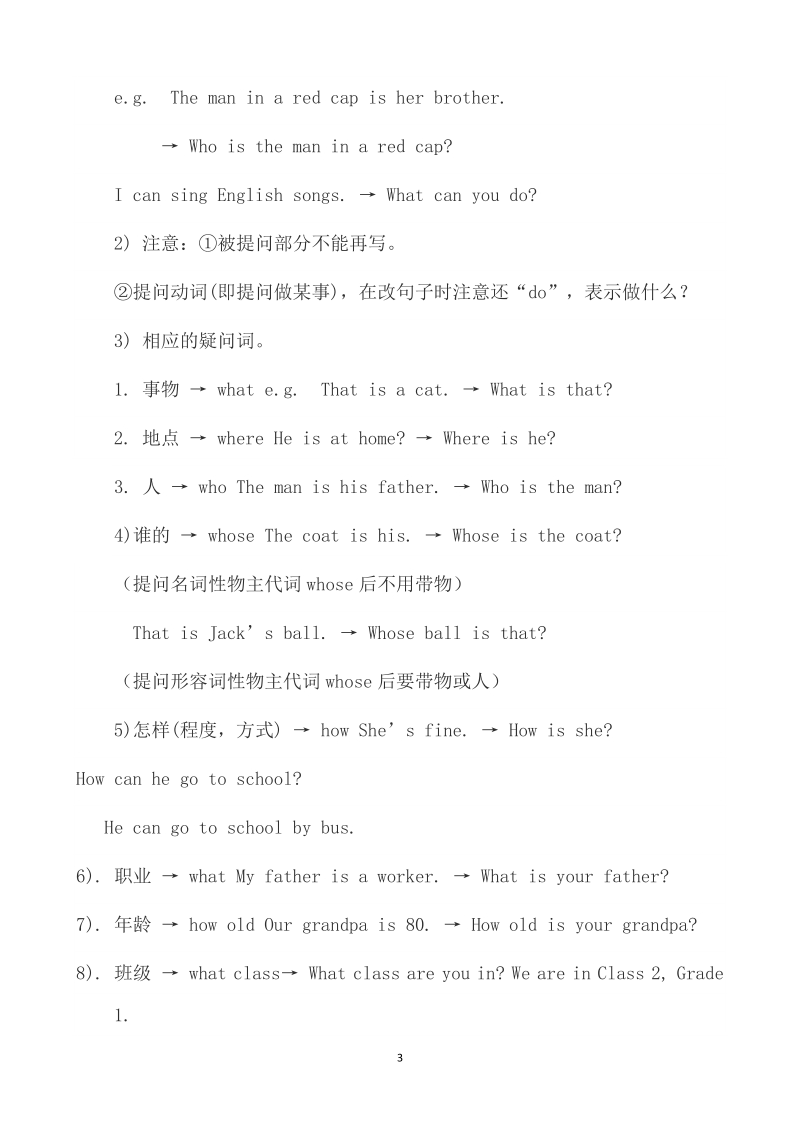 2020年秋人教版新目标七年级英语上期末语法基础知识点复习(全册)
2020年秋人教版新目标七年级英语上期末语法基础知识点复习(全册)
《2020年秋人教版新目标七年级英语上期末语法基础知识点复习(全册)》由会员分享,可在线阅读,更多相关《2020年秋人教版新目标七年级英语上期末语法基础知识点复习(全册)(15页珍藏版)》请在七七文库上搜索。
1、 1 七年级英语上期末七年级英语上期末语法基础知识点语法基础知识点复习复习(全册)(全册) (一)be 动词。 1 1、bebe 动词概说。动词概说。( (包括包括 am,am, are,are, is)is) 连系动词,本身有词义“是”,在句子中和其后的表语一起构成谓语。 e.g. I am tall.(表语) 助动词,无词义。 e.g. He is playing football. 2 2、bebe 动词的用法。动词的用法。 am 主语是单数第一人称(即 I)。 e.g. I am be are 单数第二人称及所有复数。e.g. You are The coats are 3is 单数第
2、三人称及不可数名词。e.g. Your father is The money is 3 3、否定句式(即改否定句):在、否定句式(即改否定句):在 bebe 动词之后动词之后+not,+not, 句子其它部位不变。句子其它部位不变。 e.g. He is not a teacher. 4 4、缩写形式。、缩写形式。 主语+be, 缩写 be 第一个字母为 , 再与主语合并。 e.g. you are you re Jack is Jacks be+not 否定形式的缩写,缩写 not 中“o”为 , 再与 be 合并。 e.g. is notisnt are notarent 不能缩写的情况
3、:this is, these are, those are, am not 及缩略的肯定回 答。 2 e.g. Yes, I am. (Im 误) 5 5、含、含 bebe 动词句子的疑问句型转换。动词句子的疑问句型转换。 一般疑问句:将 be 动词提前,其它照抄不变,最后+?,读升调。(一般第 一人称改为第二人称) e.g. The man in the car is her father. Is the man in the car her father? Im a middle school student. Are you a middle school student? 一般疑问句
4、的肯否定回答。 肯定回答: Yes, 主语+be. 否定回答: No, 主语+ be+ not. e.g. Is he old? Yes, he is. /No, he is not. Are you a new student? Yes, I am./ No, Im not. Is your father at home? Yes, he is. /No, he is not.(isnt) 注意:主语必须用代词回答;肯定回答不能缩写;回答第二人称, 用第一人称回答。 特殊疑问句(就划线部分提问)。 1) 方法:将句子被提问(即被划线)的部分改为相对应的疑问词,然后置于 句首,接着再将 be
5、动词或情态动词提前 (置于疑问词之后), 其它部分照抄不变, 最后+?(即疑问词+一般疑问句?) 3 e.g. The man in a red cap is her brother. Who is the man in a red cap? I can sing English songs. What can you do? 2) 注意:被提问部分不能再写。 提问动词(即提问做某事),在改句子时注意还“do”,表示做什么? 3) 相应的疑问词。 1. 事物 what e.g. That is a cat. What is that? 2. 地点 where He is at home? Wh
6、ere is he? 3. 人 who The man is his father. Who is the man? 4)谁的 whose The coat is his. Whose is the coat? (提问名词性物主代词 whose 后不用带物) That is Jacks ball. Whose ball is that? (提问形容词性物主代词 whose 后要带物或人) 5)怎样(程度,方式) how Shes fine. How is she? How can he go to school? He can go to school by bus. 6). 职业 what
7、My father is a worker. What is your father? 7). 年龄 how old Our grandpa is 80. How old is your grandpa? 8). 班级 what class What class are you in? We are in Class 2, Grade 1. 4 9)数字 what My phone number is 2212121 Whats your phone number? 10)哪一个 which Which boy is Mike? The boy in a blue shirt is Mike.
8、 (一般 which 用来提问定语,并且后要带物或人) 11). 颜色 what colour His car is yellow. What colour is his car? 12. 数量 how many+可数复数名词 There are two books on the desk. How many books are there on the desk? how much+不可数名词 There is only a little water in the glass. How much water is there in the glass? 13)时间 what time Wha
9、t time can you get there? I can get there at six. when When can you go with me? I can go with you on Sunday. 14)价钱 how much How much is the bag? The bag is twenty yuan. (二)代词:(二)代词: 1 1、代词的形式、代词的形式 5 2 2、代词的用法、代词的用法 动作的发出者, 代词用主格, (一般在句首, 动词前)。 e.g. He often writes to me. 动作的承受者,代词用宾格,(一般在句末,动词后、介词后
10、)。 e.g. Lets ask him. Lets play with them. 物的主人,用物主代词。(即代词所有格) 1)形容词性物主代词后一定要带物,不能单独使用,一般用在名词前。 e.g. This is their classroom. That is my bike. It is her red coat. 2)名词性物主代词,相当于形容词性物主代词+物。 e.g. The books are hers. (her books) 6 The bike is his. (his bike) 3)形容词性物主代词与名词性物主代词之间的区别: 形容词性物主代词:后要带物(即名词)。I
11、ts my pen. 名词性物主代词:后不带物。 Its mine. (因此填物主代词应注意判断后有无带物,有用形容词性物主代词,无即用 名词性物主代词。) 4)名词性物主代词作主语,要注意 be 的形式。 e.g. These are not her pens. Hers are in the bag. (her pens) This is not our classroom. Ours is over there. (our classroom) 5) 含形容词性物主代词与含名词性物主代词的句子可以转换。 (译法稍有不同) e.g. This is her pen This pen is
12、hers. Those black cats are his. Those are his black cats. 6)提问物主代词用 whose. e.g. This is my pen. Whose pen is this? These pens are mine. Whose are these pens? 注意: 1. 提问形容词性物主代词,用 Whose+物。 2. 提问名词性物主代词,用 Whose. 7 3. Whose + be + 主语,be 根据主语判断。 7)whose 句型的转换。e.g. Whose coat is this? Whose is this coat?
13、(三)所有格:表示物或人的“所属”关系。(三)所有格:表示物或人的“所属”关系。 1 1、名词所有格的形式:、名词所有格的形式: 名词之后直接+s e.g. MaryMarys KateKates 以 s 结尾的名词只加 e.g. studentsstudents 2 2、 以上形式一般只用于有生命的名词, 但也可用于表示时间、 距离、 国家、 以上形式一般只用于有生命的名词, 但也可用于表示时间、 距离、 国家、 地点等无生命的名词。地点等无生命的名词。 e.g. todays newspaper; an hours walk; Chinas city 3 3、注意:、注意: 表示两者或多者
14、共有,在最后一个名词表示两者或多者共有,在最后一个名词+ + s s。 e.g. Mike and Jims room.(共用,用单数) 如果不是共有,指各有,则各词都应+s。 e.g. Mikes and Jims rooms. (各有,用复数) 4 4、表示无生命的名词所有格用、表示无生命的名词所有格用 ofof 短语表示,但注意词序与汉语习惯不同,形短语表示,但注意词序与汉语习惯不同,形 式为:名词式为:名词+of+of+名词(前者属于后者)。名词(前者属于后者)。 8 e.g. the door of the room. 那房间的门 the picture of my family.
15、我 的家庭的照片 5 5、注意:有时、注意:有时s s 结构可以转化为结构可以转化为 ofof 短语。(对等)短语。(对等) e.g. his fathers friends the friends of his father. the girls new bike the new bike of the girl. the dogs name the name of the dog 但不是所有 of 结构都有对等的s 结构。因为s 只用于有生命的词。 (四)名词的数。(四)名词的数。 1 1、 名词的概念:、 名词的概念: 名词是指表示人、 事物、 地点或抽象概念名称的词, 如: teach



- 配套讲稿:
如PPT文件的首页显示word图标,表示该PPT已包含配套word讲稿。双击word图标可打开word文档。
- 特殊限制:
部分文档作品中含有的国旗、国徽等图片,仅作为作品整体效果示例展示,禁止商用。设计者仅对作品中独创性部分享有著作权。
- 关 键 词:
- 2020 年秋人教版 新目标 年级 英语 期末 语法 基础 知识点 复习
 七七文库所有资源均是用户自行上传分享,仅供网友学习交流,未经上传用户书面授权,请勿作他用。
七七文库所有资源均是用户自行上传分享,仅供网友学习交流,未经上传用户书面授权,请勿作他用。



 浙公网安备33030202001339号
浙公网安备33030202001339号
链接地址:https://www.77wenku.com/p-157456.html